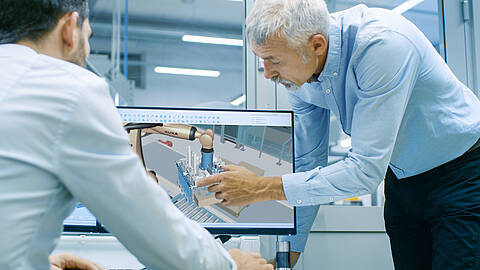
Offline programming
Offline programming for industrial robots
We program robots, sensors and PLCs with state-of-the-art software. This includes designing robot cells in 3D as well as conducting offline simulations prior to production. With this approach, we can design and test production processes in a dynamic 3D environment, define and validate production process sequences with realistic behaviours and optimised cycle times and simulate the initial start-up of production systems. Manufacturing schemes are tested virtually in advance in order to eliminate design flaws early on and verify information flows between the PLC and the robots. All these preparations get your system up and running much sooner.
Use of the latest offline programming systems
The robot itself does not have to be present for programming; the software is developed offline on a high-performance computer (which is not connected to the robot) on the basis of design drawings. That means that you can continue to use the robot in production, avoiding downtime during development.
The entire tool path is defined on the computer in a three-dimensional screen environment. The robot’s environment and tool are generally represented in this process as well, making it possible to explore various aspects:
- Determination of the component’s proper position in space for the process.
- What is being moved, the workpiece or the tool?
- Can the robot even reach the areas it needs to access?
- How much time does the robot need for this series of movements?
- Will this program cause collisions with the robot’s surroundings?
- Exploring of alternatives: for example, can a “smaller”, more cost-efficient robot be used instead of the originally planned model?
- Ensuring feasibility of the robot application.
Advantages of offline programming combined with simulation
- The robot can be programmed even before it is set up
- Design and engineering flaws can be identified early on. Changes can be made on the computer if necessary, avoiding the need for costly on-site modifications.
- Extensive changes to robot applications are often much easier to implement through offline programming than through direct modification of the robot.
- In the 3D computer environment, every part of the robot environment can viewed from all sides. In real life, certain perspectives are often concealed or hard to access.
Once the software is finished and has been tested offline, it is transferred to the robot and can be executed immediately.
The use of offline programming can boost the profitability of robots particularly in machining processes, as it can reduce the time required to put them into service and minimise the need for subsequent modifications. Layout diagrams, additional axes and multi-robot solutions can be designed more comfortably and transparently, too.
